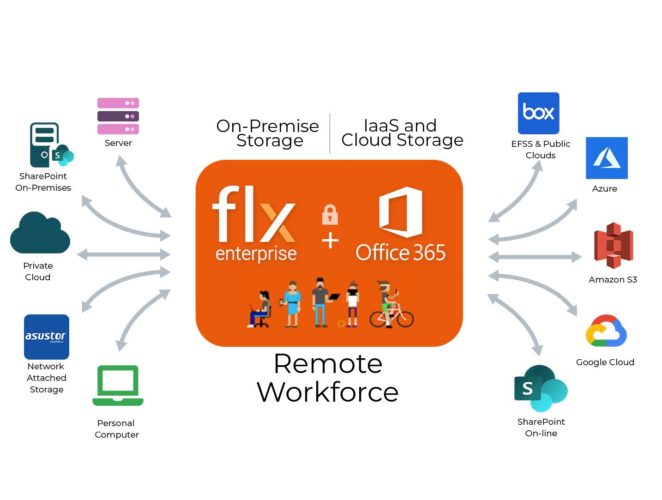
The challenge comes when you want to access or share files stored on your hybrid-IT infrastructure other than on your own OneDrive or desktop computer or when you need to maintain privacy and confidentiality over files in that you do not want them stored on a public cloud where they are subject to access by third-parties.
How to add hybrid-IT zero-trust access, enhanced security, IT control and improved productivity to Office 365
Estimated reading time: 3 minutes
What is Office?
Microsoft Office is a suite of productivity apps originally launched in the 1980s to run natively on a PC before the rise of mobile devices and the distributed workforce. At that time most users were plugged into their office network or worked exclusively from their PC hard drive.
How has Office been evolving?
Today users work from anywhere and with the recent pandemic, working full-time from home is now the norm, not the exception or just on Fridays. When working from home, users don’t connect over the internal network, they connect via the internet. Organizations needed to provide tools to enable modern distributed workforce efficiencies.
With the changes in the way modern workers work, Microsoft has also evolved the way Office operates. It has moved from being an app that ran natively from the PC hard drive to a hybrid cloud-based platform that Microsoft calls Office 365.
What is Office 365?
Microsoft Office 365 is a consistently evolving suite of applications that attempts to solve a relatively wide range of business challenges. Traditionally the two core components have been Exchange Email with Outlook, and the Productivity Suite. Today Office 365’s Enterprise version comes with the traditional email and productivity suites plus Skype for online conferencing, Microsoft Teams for collaboration, Planner, Groups, Share Point and One Drive.
How does Office 365 address the remote workforce?
Office 365 addresses remote access and file sharing through Microsoft’s cloud-hosted public storage service called OneDrive. While moving to a cloud-based platform like the one Microsoft is offering does have its advantages, that doesn’t mean it’s the right solution for every business.
Office does not address the hybrid-IT infrastructure
Today’s modern organization has a hybrid-IT infrastructure – that is a combination of on-premises and cloud-hosted servers and storage. Some information is stored on server-attached storage such as a SAN or DAS, some on network-attached storage such as a NAS and some on the user’s PC. On top of that, a lot of key information is stored on a legacy on-premises implementation of SharePoint. When it comes to cloud-hosted infrastructure, they are using Amazon, Azure, Google or other cloud services. In addition, individual departments may be using enterprise-grade cloud storage located on Dropbox or Box and individual users may be using public cloud storage on Google Drive or OneDrive. On top of all that, all of these are essentially separate silos. And because of the complexity and shadow IT, it is extremely difficult for IT to maintain control and sovereignty over that data – if at all.
The problem with using Office 365 for remote workers
The problem is that Office 365 only provides remote access to one of these many places your files might be – that is OneDrive. That forces your users to either copy and sync their important files to OneDrive or to use OneDrive as their primary storage.
The challenge comes when you want to access or share files stored on your hybrid-IT infrastructure other than on your own OneDrive or desktop computer or when you need to maintain privacy and confidentiality over files in that you do not want them stored on a public cloud where they are subject to access by third-parties.
Extending Office 365 with FileFlex Enterprise
This is why you need FileFlex Enterprise. From a single-pane-of-glass unified dashboard, users can access, share and collaborate on any Office 365 file located anywhere on this hybrid-IT infrastructure – from on-premises storage such as a NAS, SAN, DAS, PC or on-premises implantation of SharePoint, to cloud-hosted infrastructure such as Amazon, Azure, Google, to enterprise-grade cloud storage such as Box to public cloud storage such as Dropbox, Google Drive and OneDrive. It provides access to all of these over an ordinary internet connection, without the need for a VPN. And it does so with the highest levels of security available – through a zero-trust platform.
How to give IT control over remote access and sharing
FileFlex Enterprise provides IT with the tools to regain control and visibility over all remote access and file sharing in the organization including Office 365 files. It makes workers more productive and lowers their carbon footprint. Finally, since it is a software-only solution that you add to your existing storage and because you do not need to buy more storage or buy expensive data center storage, it is very cost-effective.
Our next blog will highlight some of the benefits in detail of using FileFlex Enterprise with Office 365.
Watch the Webinar: